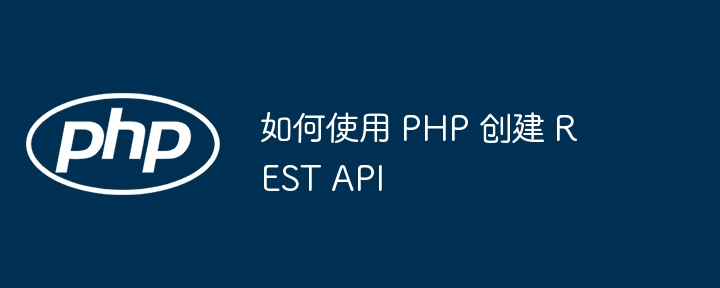How to create a REST API using PHP
Creating a REST API using PHP involves the following steps: Install PHP and the RESTful API framework. Create API routes to handle HTTP requests. Define the controller and its methods to handle routing requests. Format API responses, including status codes and JSON data. Learn how to create a REST API using PHP and Laravel through practical examples.

How to create a REST API using PHP
Introduction
REST API is used A lightweight architecture for building distributed systems. It allows applications to interact with remote servers through HTTP requests. Creating a REST API using PHP is relatively simple and provides powerful backend support in a variety of scenarios.
Installing prerequisite components
Before you begin, you need to make sure you have the following components installed:
- PHP
- RESTful API framework (such as Laravel, Slim, or CodeIgniter)
Creating an API route
First, you need to create a route for handling HTTP requests. Here is an example using Laravel:
Route::get('users', 'UserController@index');
Route::post('users', 'UserController@store');
Route::get('users/{id}', 'UserController@show');
Route::put('users/{id}', 'UserController@update');
Route::delete('users/{id}', 'UserController@destroy');Define controllers and methods
Next, you need to create controllers and their corresponding methods to handle requests in routes .
class UserController extends Controller
{
public function index()
{
$users = User::all();
return response()->json($users, 200);
}
// 其他控制器方法
}Formatting API Responses
Using the RESTful API framework, you can easily format API responses, including status codes, JSON data, and more.
Practical Case
The following is a practical case using PHP and Laravel to create a simple REST API:
- Create a file named ## Laravel project for #user-api
.Create - UserController.php
controller in the project directory.Define routes and controller methods. - Start the project and access the API endpoint (e.g.
- http://localhost:8000/api/users
).
Conclusion
Creating a REST API using PHP is relatively simple. By following the steps in this article and leveraging the available RESTful API frameworks, you can easily build a fully functional backend system.The above is the detailed content of How to create a REST API using PHP. For more information, please follow other related articles on the PHP Chinese website!

Hot AI Tools

Undresser.AI Undress
AI-powered app for creating realistic nude photos

AI Clothes Remover
Online AI tool for removing clothes from photos.

Undress AI Tool
Undress images for free

Clothoff.io
AI clothes remover

AI Hentai Generator
Generate AI Hentai for free.

Hot Article

Hot Tools

Notepad++7.3.1
Easy-to-use and free code editor

SublimeText3 Chinese version
Chinese version, very easy to use

Zend Studio 13.0.1
Powerful PHP integrated development environment

Dreamweaver CS6
Visual web development tools

SublimeText3 Mac version
God-level code editing software (SublimeText3)

Hot Topics
 PHP 8.4 Installation and Upgrade guide for Ubuntu and Debian
Dec 24, 2024 pm 04:42 PM
PHP 8.4 Installation and Upgrade guide for Ubuntu and Debian
Dec 24, 2024 pm 04:42 PM
PHP 8.4 brings several new features, security improvements, and performance improvements with healthy amounts of feature deprecations and removals. This guide explains how to install PHP 8.4 or upgrade to PHP 8.4 on Ubuntu, Debian, or their derivati
 CakePHP Date and Time
Sep 10, 2024 pm 05:27 PM
CakePHP Date and Time
Sep 10, 2024 pm 05:27 PM
To work with date and time in cakephp4, we are going to make use of the available FrozenTime class.
 CakePHP File upload
Sep 10, 2024 pm 05:27 PM
CakePHP File upload
Sep 10, 2024 pm 05:27 PM
To work on file upload we are going to use the form helper. Here, is an example for file upload.
 Discuss CakePHP
Sep 10, 2024 pm 05:28 PM
Discuss CakePHP
Sep 10, 2024 pm 05:28 PM
CakePHP is an open-source framework for PHP. It is intended to make developing, deploying and maintaining applications much easier. CakePHP is based on a MVC-like architecture that is both powerful and easy to grasp. Models, Views, and Controllers gu
 How To Set Up Visual Studio Code (VS Code) for PHP Development
Dec 20, 2024 am 11:31 AM
How To Set Up Visual Studio Code (VS Code) for PHP Development
Dec 20, 2024 am 11:31 AM
Visual Studio Code, also known as VS Code, is a free source code editor — or integrated development environment (IDE) — available for all major operating systems. With a large collection of extensions for many programming languages, VS Code can be c
 CakePHP Creating Validators
Sep 10, 2024 pm 05:26 PM
CakePHP Creating Validators
Sep 10, 2024 pm 05:26 PM
Validator can be created by adding the following two lines in the controller.
 CakePHP Quick Guide
Sep 10, 2024 pm 05:27 PM
CakePHP Quick Guide
Sep 10, 2024 pm 05:27 PM
CakePHP is an open source MVC framework. It makes developing, deploying and maintaining applications much easier. CakePHP has a number of libraries to reduce the overload of most common tasks.
 How do you parse and process HTML/XML in PHP?
Feb 07, 2025 am 11:57 AM
How do you parse and process HTML/XML in PHP?
Feb 07, 2025 am 11:57 AM
This tutorial demonstrates how to efficiently process XML documents using PHP. XML (eXtensible Markup Language) is a versatile text-based markup language designed for both human readability and machine parsing. It's commonly used for data storage an






